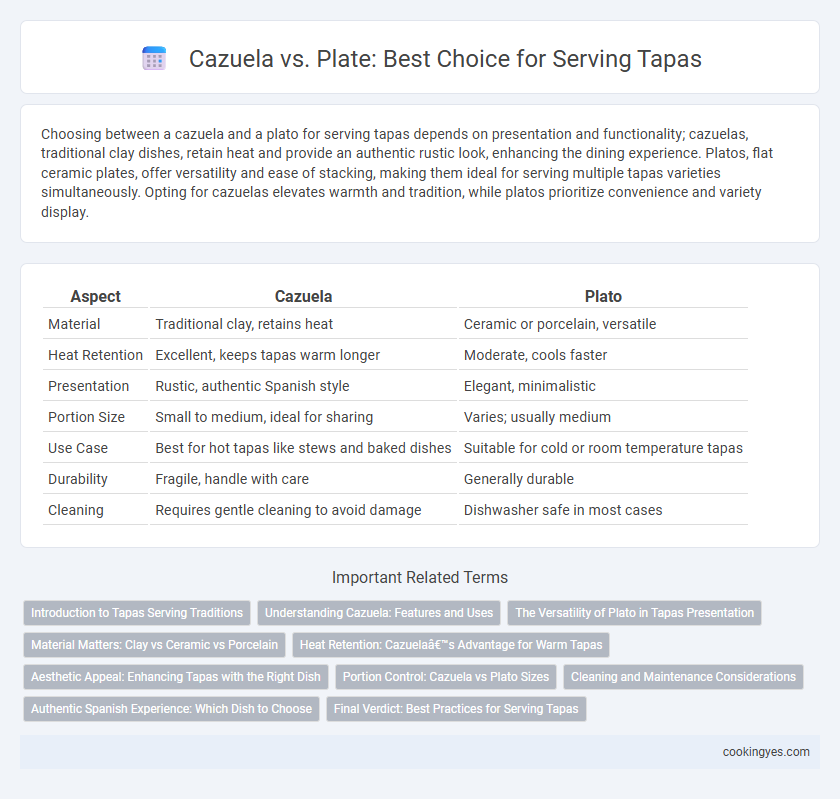Choosing between a cazuela and a plato for serving tapas depends on presentation and functionality; cazuelas, traditional clay dishes, retain heat and provide an authentic rustic look, enhancing the dining experience. Platos, flat ceramic plates, offer versatility and ease of stacking, making them ideal for serving multiple tapas varieties simultaneously. Opting for cazuelas elevates warmth and tradition, while platos prioritize convenience and variety display.
Table of Comparison
| Aspect | Cazuela | Plato |
|---|---|---|
| Material | Traditional clay, retains heat | Ceramic or porcelain, versatile |
| Heat Retention | Excellent, keeps tapas warm longer | Moderate, cools faster |
| Presentation | Rustic, authentic Spanish style | Elegant, minimalistic |
| Portion Size | Small to medium, ideal for sharing | Varies; usually medium |
| Use Case | Best for hot tapas like stews and baked dishes | Suitable for cold or room temperature tapas |
| Durability | Fragile, handle with care | Generally durable |
| Cleaning | Requires gentle cleaning to avoid damage | Dishwasher safe in most cases |
Introduction to Tapas Serving Traditions
Tapas serving traditions vary significantly between cazuelas and platos, each offering distinct cultural and practical benefits. Cazuelas, traditional clay pots, retain heat effectively, enhancing the flavors and presentation of hot tapas, while platos, flat plates, are ideal for cold or mixed tapas, emphasizing aesthetic arrangement. Understanding these serving vessels enriches the authentic tapas experience and highlights regional Spanish culinary customs.
Understanding Cazuela: Features and Uses
Cazuelas are traditional clay pots known for their excellent heat retention and even cooking, making them ideal for serving warm tapas such as stews, seafood, and slow-cooked dishes. Their porous material enhances flavors by allowing moisture to circulate during cooking, while their rustic appearance adds authenticity to the dining experience. Unlike flat platos, cazuelas are perfect for dishes that benefit from consistent heat and rich presentation.
The Versatility of Plato in Tapas Presentation
The versatility of Plato in tapas presentation lies in its ability to accommodate a variety of tapas dishes, from small bites to shared appetizers, enhancing the dining experience with its elegant and adaptable design. Unlike the traditional cazuela, which is primarily used for hot, rustic preparations, Plato provides a more refined and diverse platform that suits cold tapas, intricate garnishes, and visually appealing arrangements. Its flat surface and varied sizes make Plato ideal for both casual meals and sophisticated tapas presentations, maximizing space and promoting an inviting communal atmosphere.
Material Matters: Clay vs Ceramic vs Porcelain
Clay cazuelas provide superior heat retention and rustic appeal, ideal for traditional Spanish tapas cooking. Ceramic platos boast versatile durability and a smooth finish, combining aesthetic appeal with ease of cleaning. Porcelain plates offer elegant presentation and resistance to chipping, perfect for refined tapas serving experiences.
Heat Retention: Cazuela’s Advantage for Warm Tapas
Cazuelas, traditional clay pots, offer superior heat retention compared to flat platos, keeping tapas warm for longer periods during service. The porous nature of the cazuela material absorbs and evenly distributes heat, maintaining optimal temperature and enhancing the flavors of hot tapas dishes. This heat retention advantage makes cazuelas ideal for serving hearty, warm tapas such as gambas al ajillo or chorizo al vino, ensuring a satisfying dining experience.
Aesthetic Appeal: Enhancing Tapas with the Right Dish
Cazuelas offer a rustic charm with their vibrant earthenware texture, enhancing the visual appeal of traditional tapas and creating a warm, inviting atmosphere. Plato dishes, often sleek and minimalist, highlight the colors and arrangement of tapas, emphasizing a modern aesthetic that draws focus to the food's details. Choosing between cazuela and plato ultimately influences the dining experience by elevating either a cozy, authentic vibe or a sophisticated, contemporary presentation.
Portion Control: Cazuela vs Plato Sizes
Cazuelas, traditional clay dishes, offer precise portion control ideal for serving individual tapas, typically holding smaller servings that maintain heat well and enhance flavor. Platos, or plates, vary widely in size, allowing for more flexible portion sizes but often leading to larger servings that may disrupt the authentic tapas experience. Choosing cazuelas ensures consistent, manageable tapas portions that align with Spanish dining customs.
Cleaning and Maintenance Considerations
Cazuelas, made from unglazed clay, require careful hand-washing and thorough drying to prevent cracking and mold, while plato dishes, typically ceramic or glass, are more dishwasher-safe and easier to sanitize. The porous nature of cazuelas absorbs oils and flavors, demanding more frequent seasoning and gentle cleaning to maintain their longevity. Plat plates offer a more convenient maintenance routine, ideal for high-volume tapas service where quick turnaround and hygiene standards are critical.
Authentic Spanish Experience: Which Dish to Choose
Cazuelas are traditional earthenware dishes that retain heat and enhance the rich flavors of classic Spanish tapas, providing an authentic sensory experience rooted in Spain's culinary heritage. Plato, meaning plate in Spanish, offers versatility and simplicity for tapas presentation but lacks the rustic charm and warmth of cazuelas that many associate with genuine Spanish dining. Choosing cazuelas delivers a more immersive and culturally authentic tapas experience, reflecting true Spanish gastronomic traditions.
Final Verdict: Best Practices for Serving Tapas
Cazuelas, traditional Spanish clay pots, retain heat effectively and add authentic rustic charm when serving tapas, enhancing flavors in dishes like gambas al ajillo or chorizo al vino. Platos, or plates, offer versatility and ease of presentation, making them ideal for a tapas spread with a variety of cold and hot options, facilitating shared dining experiences. For best practices, use cazuelas for warm, sauced, or baked tapas to preserve texture and warmth, while platos suit finger foods and cold tapas, balancing practicality with authenticity.
Cazuela vs Plato for serving tapas Infographic

 cookingyes.com
cookingyes.com